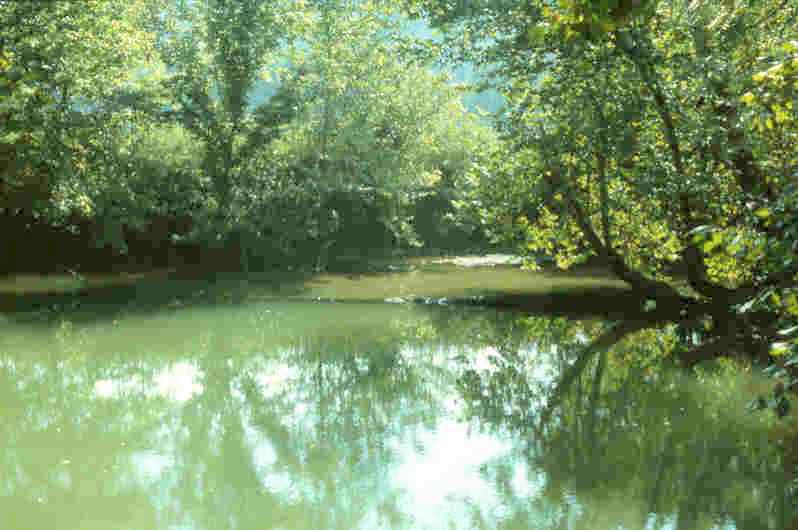- Harrison Spring
thumb|300px|Harrison Spring38°14'40" N86°13'29" W Harrison Spring is the name of the largest spring in the state ofIndiana . It is located in west-central Harrison County, near theBlue River and just north of White Cloud.The Spring
A portion of the water that feeds the spring originates from Indian Creek, and then goes underground until it reaches the spring area. The spring percolates through a layer of
Pleistocene alluvium cavern (Karst ) beneath the surface of the ground and flows into a pool measuring convert|100|ft|m by convert|80|ft|m, about convert|800|sqft|m2|abbr=on of surface area, and contains 86 millions gallons of water. [ [http://books.google.com/books?id=xU5NF4EAbQMC&pg=PA6&dq=harrison+spring+indiana&as_brr=3&sig=vtmZ2aQQILJjADDIVYbfEFFG4KI#PPA5,M1 Amazing Tales from Indiana By Fred D. Cavinder, 1990, Pg 6] ] It is within an abandoned meander loop, and in the periphery a natural levee. [ [http://www.nature.nps.gov/nnl/Registry/USA_Map/States/Indiana/NNL/HS/index.cfm NPS: Nature & Science » National Natural Landmarks] ] Divers have measured its depth to be between 35 and convert|40|ft|m. It produces at least 3 million gallons of water a day at an average of 18,000 gpm, [ [http://www.in.gov/dnr/water/publications/pdf/5361.pdf Hydrology of Harrison County, Pg 19] ] enough to supply water to an average town of 12,000. [ [http://books.google.com/books?id=xU5NF4EAbQMC&pg=PA6&dq=harrison+spring+indiana&as_brr=3&sig=vtmZ2aQQILJjADDIVYbfEFFG4KI#PPA5,M1 Amazing Tales from Indiana By Fred D. Cavinder, 1990, Pg 5] ] On rainy days the spring can produce as much as 30 million gallons of water a day. ["Harrison Spring bubbling with history of our ninth president" Louisville Courier Journal April 2, 1978] The water from the spring overflows into a an outlet that travels about half a mile before merging with Blue River as a tributary.The spring is similar to many other spring around the Lost River, a large underground river that flows through Indiana roughly parallel to the
Ohio River , and may be one of its several outlets. The spring is located at the low point of asubterranean gradient that the Indian Creek flows over at a higher point. Dye tests have shown that water can percolate through thekarst from Indian Creek to Harrison Spring, a four mile (6 km) distance, in as little as four hours. [ [http://www.in.gov/dnr/water/publications/pdf/5361.pdf Hydrology of Harrison County, Pg 19] ] The spring is also linked with theWyandotte Caves , the largest cave system in the state, whose main entrance is about five miles (8 km) west of the spring.History
The spring is part of a property that is now owned by Robert Rosenbarger, but it was once part of a large convert|600|acre|km2|sing=on farm owned by
United States PresidentWilliam Henry Harrison from whom it gains its name. The spring produced enough water to run agristmill andsawmill downstream which began operating 1807, making it one of the first in the state. [ [http://books.google.com/books?id=dKMNAAAAYAAJ&pg=PA483&dq=harrison+spring+indiana&as_brr=3#PPA483,M1 Water Resources If Indiana and Ohio, by Frank Leverett, 1897, Pg 483] ] [ [http://books.google.com/books?id=xU5NF4EAbQMC&pg=PA6&dq=harrison+spring+indiana&as_brr=3&sig=vtmZ2aQQILJjADDIVYbfEFFG4KI#PPA5,M1 Amazing Tales from Indiana By Fred D. Cavinder, 1990, Pg 6] ] The farm was known as Harrison Valley. Harrison had planned to make it a plantation similar toGrouseland , and a shipyard. However, the outlawing of slavery by the Indiana legislature made this impossible.The spring is a registered
National Natural Landmark , but it is not open to the public.References
* [http://www.indiana.edu/~librcsd/etext/hoosier/GM-13.html Harrison Spring: One of the Largest in the Midwest]
* [http://homepages.ius.edu/Special/Darters/HSDescr.htm Harrison Springs]
Wikimedia Foundation. 2010.

